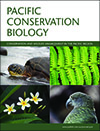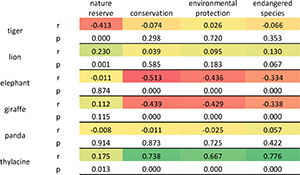
Pacific Conservation Biology
Volume 27 Number 3 2021
Fatal toxoplasmosis has been reported in multiple New Zealand native species, including Hector’s and Māui dolphins, and kiwi. This review summarises relevant research on toxoplasmosis in New Zealand wildlife, identifies priorities for managing the conservation risks of toxoplasma, and defines the critical knowledge gaps currently constraining management options.
We identify a major flaw in the EPBC Act listing framework for threatened ecological communities: restrictive condition thresholds that threaten ecosystem function in dynamic ecosystems. Description of alternative states for dynamic systems should be formally integrated into listing processes to protect Australia’s vulnerable ecosystems from further degradation and loss.
PC20040 Abstract | PC20040 Full Text | PC20040PDF (1.1 MB) Open Access Article
PC20072Evaluation of lethal control of introduced sugar gliders as a tool to relieve bird nest predation
Lethal control of invasive mammalian predators can be controversial and is rarely a ‘silver bullet’ for conservation problems. We implemented a before-after-control-impact experiment to remove sugar gliders from three treatment sites and protect nesting birds. Lethal control of gliders yielded low capture rates and no discernible conservation benefit.
Agriculture is pervasive throughout the world and can negatively affect species. I compared population attributes of western pond turtles at an agricultural site from 1999 to 2009 and found higher numbers of young but significantly fewer large adults in 2009. Loss of large adults could be a conservation concern.
This study investigated habitat selection and detection rate of Mixophyes iteratus in the Tweed Valley, northern New South Wales, Australia. Raw data and occupancy modelling indicated that the species selected pools with undercut banks, which provide strata to lay eggs and for hatchling tadpoles to complete metamorphosis. Future management should concentrate on protecting these habitat features and conducting a minimum of two frog surveys at favourable sites in favourable conditions to accurately assess the occupancy of the species.
PC20047Apparent absence of the amphibian chytrid fungus (Batrachochytrium dendrobatidis) in frogs in Malaita Province, Solomon Islands

We surveyed for B. dendrobatidis, the pathogen responsible for the devastating amphibian disease, chytridiomycosis, for the first time in the Solomon Islands. All 200 frogs sampled tested negative. If truly absent, the introduction of the pathogen to the unique and culturally significant frog fauna of the country could be catastrophic.
PC20047 Abstract | PC20047 Full Text | PC20047PDF (534 KB) Open Access Article
PC20059Urban landscape attributes affect occupancy patterns of the San Joaquin kit fox during an epizootic
 , Brian L. Cypher, James Murdoch, Tory L. Westall, Erica C. Kelly and David J. Germano
, Brian L. Cypher, James Murdoch, Tory L. Westall, Erica C. Kelly and David J. Germano 
The imperiled San Joaquin kit fox (Vulpes macrotis mutica) persists in the urban environment of Bakersfield, California, USA. In this study we found kit fox occupancy patterns were primarily positively affected by campuses and negatively affected by paved roads.
Opuntia stricta was found to be associated with homogenisation within the dunal communities in which it commonly dominated. However, the magnitude of these effects on diversity and the inability to eradicate the species may not constitute effective use of labour, funds and time and the potential detrimental effects of long-term use of herbicides. There are limited resources available and such resources need more specific targeting to maximise the chances of reducing biodiversity loss.
To save the tooth-billed pigeon of Samoa from extinction we need to learn how to separate its call from that of a common sympatric species. An attempt was made to do this by harnessing the ecological knowledge of the indigenous pigeon hunters. Two sonographic differences were found.
PC20052 Abstract | PC20052 Full Text | PC20052PDF (1.7 MB) | PC20052Supplementary Material (246 KB) Open Access Article
PC20049Screening of diseases in wild exotic birds on Tahiti Island – implications for French Polynesian conservation
 , Susana Saavedra, Tehani Withers, Jan Votýpka, Karine Laroucau, Steeve Lowenski and David Modrý
, Susana Saavedra, Tehani Withers, Jan Votýpka, Karine Laroucau, Steeve Lowenski and David Modrý
The potential role of introduced birds as vectors of zoonosis in French Polynesia and the crucial finding of P. relictum with several ubiquitous and dangerous pathogens on Tahiti Island should be given the appropriate attention by local authorities and conservationists.
PC20090Can Google Trends data confirm the need for charismatic species to generate interest in conservation?

This study compared interest in selected charismatic species using Google Trends with the terms nature reserve, conservation, environmental protection and endangered species from the field of nature and environmental protection in three selected English-speaking countries and worldwide. Although some individual, selected terms, e.g. panda or thylacine, could be valuable ambassadors for nature and environmental protection in certain regions, a more general benefit or need for charismatic species to generate interest in conservation and environmental issues has therefore not been clearly demonstrated in this study.
Giant Boarfish (Paristiopterus labiosus) life history is poorly known despite the increasing recreational fishery interest and a characteristic spawning behaviour. We report the capture of a large specimen and its first age determination using sectioned otoliths to 36 years.
The scaled stargazer Pleuroscopus pseudodorsalis is a rarely seen, deep-water species. A specimen removed from the stomach of a bass groper increases our knowledge of the distribution of P. pseudodorsalis and the estimated age of 22 years, determined from sectioned otoliths, is the first such information for this species.



